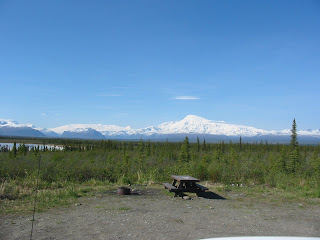The Nabesna area finally got some much needed rain over the past few days. It has brought the water up in the creeks and made

Mile 15 – Mile 17.5: The road is rough in this area with numerous pot holes.
Trail Creek (Mile 29) has shallow water crossing the road.
Lost Creek (Mile 30.8) has a moderate flow of water across the road and has a channel. The bottom is still firm so four wheel drive is not required. Medium and high clearance vehicles are recommended. Low clearance vehicles should use caution.
Boyden Creek (Mile 34.3) has 6 to 8 inches of water flowing across the road and has formed a channel. The crossing is rough and medium to high clearance is required.
Techniques for stream crossings:
- Evaluate the stream before crossing. If the water is too murky to see the bottom, find a long stick to probe for depth.
- Check to determine if the bottom is firm. If your feet sink into the gravel very much this could mean that the bottom is soft. In the case of a soft creek bottom, you may need four wheel drive.
- If you decide to make the crossing, stay committed. Don’t let off the gas once you start across and maintain momentum until you are clear of all water.
- Speed should be enough to maintain momentum – you don’t need to “floor it”.
- When crossing a channel it is often best to cross at an angle. Look for sloping banks rather than sharp edges.
- In the end, only you know your driving ability and your vehicle. Just remember that your cell phone may not work and help is a long way away – maybe even days.
Insider Tips:
Each year around Father’s Day, the Trumpeter Swan pair that nests on an island in Little Twin Lake hatches their cygnets. This year’s batch emerged either late yesterday or this morning. The adults have moved the cygnets over to 
Wildlife Sightings:
Moose
Red fox
Porcupine
Trumpeter Swans






